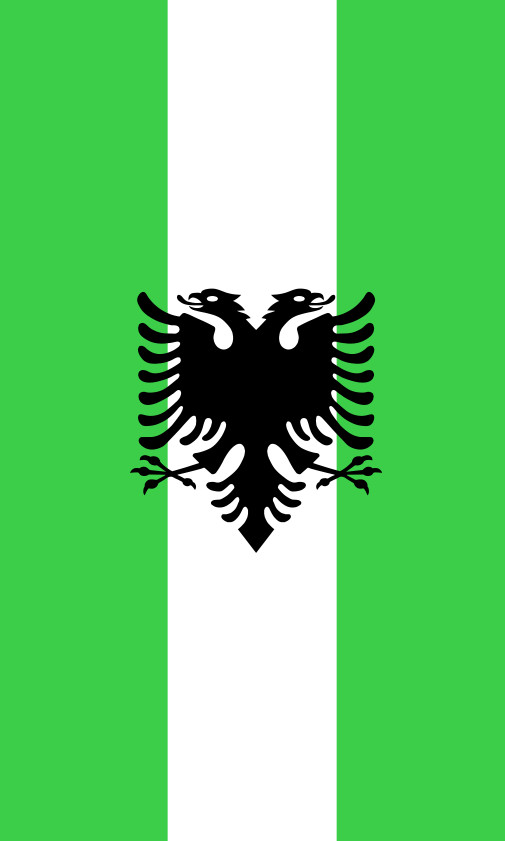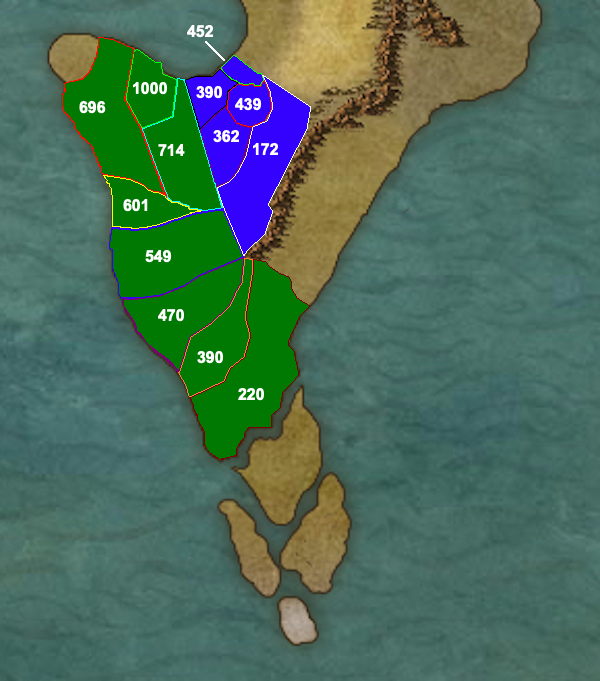The Regency of Verdon
The heartland of the Empire, spanning from the south coast of the Placid Sea down to the Broken Horn.
Structure
Nominally, the Regent of Verdon is the ruler of the land. This title is conferred by the Emperor on his firstborn son by custom. Below the King is the Grand Duke, or Dutchess, chosen by the Emperor from among the dukes of Verdon. If the Emperor has no eligible successor (as is currently the case, as the Dauphin is only 12), the Grand Duke or Dutchess assumes rulership duties. In practice, the Grand Duke rules the Kingdom and trains the King in leadership in preparation for the Emperor’s Throne.
The Kingdom is still highly feudal despite sporadic reforms. Like all other positions, Duchies of Verdon are handed out by the King to noble families of merit and can be revoked if their performance is unsatisfactory. This rarely occurs, and in practice, Duke or Duchess is otherwise a lifelong station. A Duke or Duchess rules their county as well as oversees the Margraves in their Duchy. The Grand Duke or Duchess sometimes delegates this responsibility to their Grand Margrave.
From the Duke down, each rank bears the responsibility for mustering the Levy of their district for war. The Levy of a region is defined as 90% of men aged 14-35 and 25% of unmarried women aged 16-30 by the Reforms of 309. This responsibility is called the Power of the Marshall. For the enforcement of the Marshall, each has a high ranking Yeoman assigned to them who has the power to mete our punishment to lesser noble in their name. After the reforms of 309 PE, however, the Yeomans are solely responsible to the Yeomanry, and ultimately the Emperor, for this discretion. The Power of the Marshall cannot be delegated.
Below the Duke is the Margrave. The Margrave rules a March or a Longmarch, which (depending on the territory) is as wide in distance as an army could march in either 10 days or 20 days (100 or 200 miles). As of the 309 reforms, Marches and Longmarches are divided up by population, as a Longmarch is not allowed to have a population of more than 10,000. When a Longmarch exceeds 10,000 population, it is divided into two with the more heavily populated area ruled by the current Margrave and the less heavily populated area ruled by a new Margrave selected from the Grafs of the March being divided.
A Graf rules a region called a County, so called because the "count" of its inhabitants is not to exceed 1000. Counties vary hugely in size, some larger ones can span more than a hundred miles, while some smaller ones barely cover half a mile. There is no limit to the number of counties in a March, but obviously there can only be 19 counties in a Long March. Because population is so important, a high or middle ranked Yeoman is assigned to each county to verify the Noble’s estimate of their population. In population centers with multiple Grafs, per the Reforms of 309, a commoner government is to be chartered with the Grafs ruling any surrounding area and maintaining Marshall and Judicial responsibility. The Yeomans are to ensure that the Grafs cooperate with the civilian government.
Below the Grafs are Manor Lords, and below those are Petty Lords. Manor Lords have a Manor, an estate which includes a population. Petty Lords have estates with no population.
History
Human history from before the time of the The Sixth Thalassan Crusade is scant, as much was destroyed in that brutal war. What is certain is that Verdon has existed as a nation for more than 1700 years. The Verdonese were among the first humans to arrive on Granmor from Theamor. Legend has it that the Verdonese came from an army from Theamor whisked across the sea by Wodin, who took a human form to taunt them aboard their ships. This is one of many legends that paint the ancestors of the Verdonese as being singled out for torment by Wodin. Indeed, speakers of Verdonese sublanguages could be found on the southwest coast, indicating that the people who would found the country of Verdon initially arrived on the southwest coast before migrating north towards the Placid sea.
Verdon's position on the south coast of the Placid Sea gave it a prime position for trade and expansion. As Human societies across Granmor suffered the aftermath of the Sixth Thalassan Crusade, Verdon expanded its borders south, west, and east until it owned a large swath of territory that extended along the south of Gonewald forest, then back up to Idrion in the west. In 729, the Knights of the Pit, guardians of the magically pacified volcano said to be the grave of the evil god Taron, completed an ornate castle in the sleepy fishing town of Pelmoth at the mountain's base. Verdon's King was so moved by the structure that he ordered the capital moved to Pelmoth, which was renamed Verdon City.
Verdon's rival during these times was the nation of Idrion, with the two jockeying for trade supremacy in the Placid Sea. Idrion's southward coastal expansion into lands occupied by peoples speaking Verdonese-related languages would finally lead the two to war in 714 PE, with Verdon winning in 696 and limiting Idrion to the penninsular edge of the Placid Sea.
In 682 PE, the magical protection surrounding the volcano known as the Pit failed. A group of mages formerly affiliated with the Knights of the Pit were able to shield the city from the ash and lava, although the countryside and coastline were devastated. Idrion, attempting to take advantage of this weakness, invaded the Verdonese heartland and besieged both Verdon City and Enviridian in summer 681. The Empire was able to rally its army and these same mages unleashed spells of great power, turning back the invaders. Shocked by the strength of these magic users and with the knowledge of the Elves' destructive power and decadence, the King of Verdon realized that something must be done to ensure that Humanity was not corrupted or consumed by the power of magic. He invited the heroic mages to start a government within the government, an order of Mages that would ensure the responsible use of magic. Thus in 681, one year after the eruption, The Magocracy was born. Strict laws were put into effect regulating magic and ensuring that magic users serve and uplift the state of Verdon.
Verdon would continue expanding southward over the next 400 years, defeating the kingdoms of Crofton , Dessex , Lorgar , and Hemiasta in the south, expanding its territory beyond the size of any individual kingdom (the Northern Confederations of that age and ages to come would be larger). This expansion was not merely fueled by the desire for land and riches, as it was in other Human kingdoms. Rather, it was an ideology and an identity that drove the Verdonese soldiers to victory time and time again.
Image showing Verdonese and Amathiri expansion in the Pre-Empire era.
In 452, a succession crisis in the kingdom of Amathir, on the southeastern coast of the Placid Sea, would leave that country without a king. Verdonese troops sailed to its capital, Palithrace, to assist its noble house of Melencor, whose contender for the throne had a sister married to the Archduke of Verdon. The Melencor dynasty was established there, and from that point on, Amathir would be an ally of Verdon. Over time, Amathir would carve out a respectable kingdom of its own.
Verdon's expansion was not without consequence, however. In 309, tensions within the sprawling kingdom of Verdon reached a breaking point, with factions of nobles and peasants arrayed against one another. The King introduced the Reforms of 309 to delineate the roles of nobles and the rights of peasants. The law also formally established The Yeomanry as an internal police force and a check on the Nobles as well as the Magocracy.
Just 16 years later, in 293 PE, the aristocratic bourgeois families of Idrion rebel when its Dictator resists their attempt to force him to sign a bill similar to the Reforms of 309 with them in the place of the nobility. Rather than see his own country thrust into civil war, Prince Allastair killed his own father and had his generals executed. The move backfired and as the army beseiged his castle, Allistair reached out to Verdon for aid, promising Idrion's fealty to the Empire in exchange for their support. Verdon responds immediately and breaks the siege, defeating Idrion's army and securing Idrion as a vassal state.
In 220, the Kingdom of Southmark, long an ally of Verdon, was taken over by nobles and generals loyal to them in a coup, who wanted to ally with the Elves and instigate some of the Centralian powers to fight against Verdon. In response, Verdon occupied Southmark, a situation which would continue for 220 years.
In 177 PE, explorers from Verdon established a colony on Morgranth. Several more would follow and in 119 PE New Verdon (now also known in the Union as Imperial Morgranth) established itself as a Republic, a semiautonomous subject of the Kingdom of Verdon.
In 132 PE, Verdon sent a Yeoman named Keylon Jenners to reconnoitre the Broken Horn Isles. Blown off course, he ended up in the Sharptooth Kingdom on the island of Hala, which was at the time its only secured and sovereign territory. Keylon managed to negotiate an alliance with the Sergal, which was finalized in 127 PE. Two years later, the allies began a devastating 50 year war with Fennein to take back the Broken Isles. Despite the Elven use of magical WMD, the allies were able to push them off the isles and Fennein evacuated in 72 PE.
With scant generations to recover, Verdon declared war on United Centralia in 7 PE, conquering that huge and weakened country in less than seven years.
Upon the fall of Centralia's last northern stronghold in late 1 PE, the King of Verdon announced that he was separating the government at Verdon City from the nation of Verdon in order to better rule the many and far flung subjects of Verdonese conquest, and the creation of a Union of likeminded nations for the security of Humanity and other races from magical excess and dangers. The occupation of Southmark ended— restoring most of the land that belonged to Southmark at its peak in the 1400s PE to New Southmark, a successor state that is a protectorate of the Empire.
Verdon itself was devolved into a Regency, where the successor to the Imperial Throne would be groomed to rule an entire continent by the experienced noble statesmen of Verdon. The eye of the Emperor is often far from the Kingdom of his birth, but Verdon is never far from his mind.
Territories
The Regency of Verdon controls a wide swath of Granmor that extends from its 450 mile border with Isinor at the mouth of the Placid Sea, 2500 miles down the West coast to the mouth of the Grail river, which forms its 1100 mile Eastern border with New Southmark. From its source in the Iron Mountains, the border with Gonewald extends 1500 miles along the Gonewald Forest's outskirts back up to the coast of the Placid Sea where it controls 740 miles of coastline (excluding 30 miles around Verdon City). The total area is roughly 1.86 million miles, or about half the size of the contintental US in our world.

Security, Purpose, and Well Being in the Empire’s Unity
Type
Geopolitical, Kingdom
Alternative Names
Verdon
Demonym
Verdonese
Government System
Monarchy, Absolute
Power Structure
Feudal state
Parent Organization
Location
Official Languages
Notable Members
Related Ethnicities
Remove these ads. Join the Worldbuilders Guild



Comments